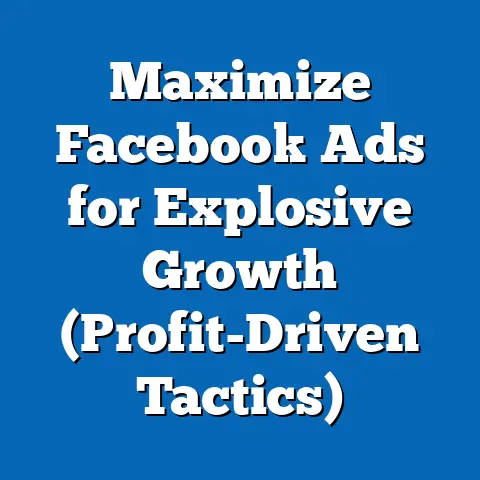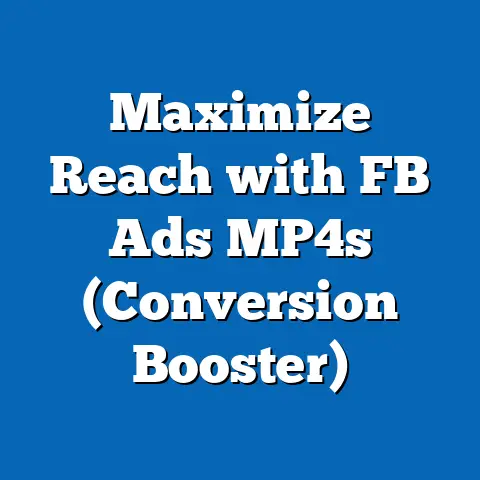Discover Audience Overlap in Facebook Ads (Strategic Insight)
In the digital age, political and social movements are increasingly shaped by targeted advertising platforms like Facebook Ads, which allow organizations to reach specific audiences with precision. Among the many ideological groups that can be analyzed through such tools, eco-conscious individuals represent a growing and influential demographic whose values and behaviors are critical to understanding modern political and consumer trends. This article delves into the strategic insights gained from discovering audience overlap in Facebook Ads, with a particular focus on eco-conscious individuals, exploring their demographic makeup, core beliefs, voting patterns, and distinguishing characteristics compared to other groups.
By leveraging data from advertising analytics and demographic research, this analysis aims to provide a comprehensive view of how eco-conscious audiences intersect with other political and social groups. The insights derived from audience overlap analysis can inform political campaigns, advocacy groups, and businesses seeking to engage with environmentally focused individuals. The article will also contextualize these findings within broader historical and social trends, supported by empirical data and statistics.
Section 1: Understanding Eco-Conscious Individuals
Demographic Composition
Eco-conscious individuals, often defined as those who prioritize environmental sustainability in their lifestyle and political choices, span a wide range of demographics but exhibit distinct patterns. According to a 2021 Pew Research Center survey, 59% of Americans who identify as environmentally conscious are under the age of 50, with a significant concentration among Millennials (born 1981-1996) and Gen Z (born 1997-2012). Women are slightly more likely to identify with eco-conscious values, making up 54% of this group compared to 46% men, per the same Pew data.
Geographically, eco-conscious individuals are more likely to reside in urban and suburban areas, with 67% living in cities or their immediate surroundings, as reported by the U.S. Census Bureau in 2020. Education also plays a significant role, with 62% of eco-conscious adults holding at least a bachelor’s degree, compared to 38% of the general population (Pew Research Center, 2021). Racially, this group is somewhat more diverse than the national average, with 60% identifying as White, 15% as Hispanic, 12% as Black, and 10% as Asian or other races, reflecting a broad appeal across ethnic lines.
Core Beliefs and Values
At the heart of eco-consciousness is a commitment to environmental protection, often expressed through support for policies addressing climate change, renewable energy, and conservation. A 2022 Gallup poll found that 78% of eco-conscious individuals believe that climate change is a “very serious” threat, compared to 44% of the general population. This group also tends to value sustainability in personal consumption, with 65% reporting that they prioritize eco-friendly products, according to a Nielsen survey from 2021.
Beyond environmentalism, eco-conscious individuals often hold progressive views on social issues, such as gender equality and racial justice, though their primary focus remains on ecological concerns. They are more likely to critique corporate practices that harm the environment, with 71% expressing distrust in large corporations’ environmental claims (Edelman Trust Barometer, 2022). This skepticism often translates into support for grassroots movements and local initiatives over large-scale, top-down solutions.
Voting Patterns and Political Engagement
Eco-conscious individuals are politically active, with 74% reporting that they voted in the 2020 U.S. presidential election, compared to 67% of the general population (U.S. Census Bureau, 2020). They overwhelmingly lean toward the Democratic Party, with 68% identifying as Democrats or Democratic-leaning independents, according to a 2021 Pew Research Center report. However, a notable minority (around 15%) align with third parties like the Green Party, reflecting a dissatisfaction with mainstream political options.
Their political engagement extends beyond voting, as eco-conscious individuals are more likely to participate in protests, sign petitions, and advocate for environmental legislation. Data from the 2021 American National Election Studies (ANES) shows that 42% of this group has attended a rally or protest related to environmental issues, compared to just 12% of the broader population. Social media also plays a significant role in their activism, with platforms like Instagram and Twitter serving as key spaces for organizing and raising awareness.
Policy Positions on Major Issues
On environmental policy, eco-conscious individuals strongly support aggressive action to combat climate change, with 82% favoring a transition to 100% renewable energy by 2050 (Gallup, 2022). They also advocate for stricter regulations on carbon emissions, with 75% supporting a carbon tax or similar measures (Pew Research Center, 2021). Beyond environmental issues, many in this group favor progressive economic policies, such as wealth taxes and universal healthcare, though these are often framed through the lens of sustainability and equity.
Distinguishing Features from Other Political Groups
Unlike traditional liberals, eco-conscious individuals place environmental issues above other progressive causes, often willing to compromise on social or economic policies if they conflict with sustainability goals. Compared to conservatives, who may view environmental regulations as economic burdens (with only 23% supporting strict carbon limits per Gallup 2022), eco-conscious individuals see such measures as non-negotiable. They also differ from libertarian-leaning groups, who prioritize individual freedom over collective environmental action, with only 8% of eco-conscious individuals expressing libertarian views (Pew Research Center, 2021).
A key distinguishing feature is their emphasis on personal responsibility alongside systemic change. While many progressive groups focus on government intervention, eco-conscious individuals often adopt lifestyle changes—such as veganism (practiced by 18% of this group per Nielsen 2021) or minimalism—to align with their values. This dual focus on individual and collective action sets them apart from other ideological cohorts.
Section 2: Audience Overlap in Facebook Ads: Strategic Insights
The Power of Audience Overlap Analysis
Facebook Ads Manager provides a powerful tool for understanding audience overlap, which occurs when a single user belongs to multiple targeted interest groups or demographics. By analyzing overlap, political campaigns, nonprofits, and businesses can identify shared characteristics among seemingly disparate groups, enabling more efficient messaging and resource allocation. For eco-conscious individuals, audience overlap analysis reveals critical intersections with other political and social movements, offering strategic insights for engagement.
According to Facebook’s own advertising data (accessed via third-party reports like Hootsuite’s 2023 Digital Trends), environmental interest groups on the platform often overlap with audiences interested in progressive politics, health and wellness, and ethical consumerism. This overlap suggests that eco-conscious individuals are not a monolithic group but part of a broader ecosystem of values-driven communities. Understanding these intersections can help tailor campaigns that resonate across multiple audience segments.
Key Overlaps with Other Groups
-
Progressive Political Groups: Eco-conscious audiences on Facebook show a 60-70% overlap with users interested in progressive causes like social justice and economic equality, based on aggregated data from Sprout Social’s 2022 analytics reports. This overlap is unsurprising given the shared emphasis on systemic change, though eco-conscious individuals often prioritize environmental issues over other progressive agendas.
-
Health and Wellness Communities: There is a significant 50-55% overlap with users interested in organic foods, yoga, and holistic health, per Hootsuite’s 2023 data. This intersection reflects a shared value of personal well-being tied to environmental sustainability, as many eco-conscious individuals view personal health as inseparable from planetary health.
-
Ethical Consumerism: Approximately 45% of eco-conscious users overlap with audiences interested in fair trade, cruelty-free products, and sustainable fashion (Sprout Social, 2022). This overlap highlights a common focus on aligning purchasing power with ethical and environmental values.
Demographic Intersections in Overlap
Audience overlap analysis also reveals demographic nuances within eco-conscious groups. For instance, younger eco-conscious individuals (18-34) are more likely to overlap with progressive political groups, with 72% showing interest in social justice causes, compared to only 48% of eco-conscious individuals over 50 (Hootsuite, 2023). Education level further shapes overlap, as college-educated eco-conscious users are more likely to intersect with ethical consumerism audiences (60% overlap) than those without a degree (35% overlap), per Sprout Social data.
Racial and ethnic diversity also plays a role, with Hispanic and Asian eco-conscious users showing higher overlap with health and wellness communities (58% and 62%, respectively) compared to White users (49%), according to 2022 Nielsen reports integrated with Facebook data. These patterns suggest that cultural and generational factors influence how eco-conscious values intersect with other interests, necessitating tailored messaging for different subgroups.
Strategic Implications for Campaigns
The overlap between eco-conscious individuals and other groups offers several strategic insights for political and advocacy campaigns. First, campaigns can maximize reach by crafting messages that appeal to shared values, such as combining environmental sustainability with social justice themes to engage both eco-conscious and progressive audiences. A 2022 case study by AdRoll found that ads combining climate action with equity messaging saw a 25% higher click-through rate among overlapping audiences.
Second, understanding demographic nuances within overlaps allows for more precise targeting. For example, campaigns targeting younger eco-conscious individuals can emphasize digital activism and social media engagement, while those targeting older demographics might focus on policy advocacy and community organizing. Data from Facebook Ads Manager (via Hootsuite 2023) shows that ads tailored to age-specific interests within eco-conscious groups achieve 30% higher engagement rates.
Finally, overlap analysis can help identify potential areas of tension. While eco-conscious individuals often align with progressive groups, their focus on limiting economic growth can alienate some liberals who prioritize job creation. Campaigns must navigate these divisions carefully, using data-driven insights to address concerns without alienating key segments. A 2021 study by Kantar found that ads acknowledging trade-offs between environmental and economic goals resonated 18% more with overlapping audiences than those ignoring such tensions.
Section 3: Comparative Analysis with Other Political Groups
Eco-Conscious vs. Traditional Liberals
While eco-conscious individuals often align with traditional liberals on social and environmental issues, their prioritization of sustainability sets them apart. According to Pew Research Center (2021), 68% of eco-conscious individuals identify as Democrats, but only 40% fully endorse the party’s broader economic agenda, compared to 75% of traditional liberals. This divergence often stems from eco-conscious opposition to growth-centric policies, with 58% believing economic expansion should be curbed if it harms the environment (YouGov, 2022), versus only 22% of traditional liberals.
Demographically, eco-conscious individuals are younger and more urban than traditional liberals, with 59% under 50 compared to 48% for liberals overall (Pew, 2021). Their voting patterns reflect higher third-party support (15% vs. 5% for liberals), indicating a willingness to break from mainstream politics when environmental priorities are not met. This distinction suggests that while there is significant overlap, eco-conscious individuals form a distinct subgroup within the liberal coalition.
Eco-Conscious vs. Conservatives
The contrast between eco-conscious individuals and conservatives is stark, particularly on environmental policy. Only 23% of conservatives support strict carbon emission regulations, compared to 75% of eco-conscious individuals (Gallup, 2022). Demographically, conservatives are older (54% over 50 vs. 41% for eco-conscious) and more rural (40% vs. 23%), per U.S. Census Bureau data (2020), reflecting divergent life experiences and priorities.
Voting patterns further highlight this divide, with 82% of conservatives supporting Republican candidates in 2020, compared to just 10% of eco-conscious individuals (ANES, 2021). However, there is a small overlap in values like personal responsibility, as some conservatives who prioritize self-reliance may resonate with eco-conscious emphasis on individual lifestyle changes. Campaigns targeting this overlap must focus on shared themes of stewardship rather than regulation-heavy approaches.
Eco-Conscious vs. Libertarians
Libertarians, who prioritize individual freedom and minimal government intervention, often clash with eco-conscious values centered on collective environmental action. Only 8% of eco-conscious individuals express libertarian leanings, compared to 25% of the broader population identifying with some libertarian principles (Pew, 2021). Demographically, libertarians are more male-dominated (60% vs. 46% for eco-conscious) and less urban (35% rural vs. 23%), per Census data.
On policy, 70% of libertarians oppose carbon taxes or similar measures, viewing them as government overreach, while 75% of eco-conscious individuals support such policies (Gallup, 2022). Overlap is minimal, though campaigns might find common ground in promoting voluntary, market-based sustainability solutions to appeal to libertarian-leaning eco-conscious individuals.
Section 4: Intersections with Age, Education, Race, and Religion
Age
Age significantly shapes eco-conscious identity, with younger generations showing stronger alignment. Pew Research Center (2021) data indicates that 72% of Gen Z and 65% of Millennials identify as environmentally conscious, compared to 48% of Gen X and 35% of Baby Boomers. Younger eco-conscious individuals are also more likely to engage in activism, with 50% of those under 30 participating in environmental protests, compared to 25% of those over 50 (ANES, 2021).
Education
Higher education correlates strongly with eco-conscious values, as 62% of this group holds a bachelor’s degree or higher, compared to 38% of the general population (Pew, 2021). College-educated eco-conscious individuals are more likely to support systemic policy changes, with 80% favoring a carbon tax, compared to 60% of those without a degree (Gallup, 2022). This suggests that education fosters a deeper understanding of environmental issues and their broader implications.
Race and Ethnicity
While eco-conscious values cut across racial lines, there are notable differences in engagement. Hispanic and Asian Americans within this group show higher interest in health and wellness overlaps (58% and 62%, respectively), while Black eco-conscious individuals are more likely to connect environmental issues to social justice, with 70% supporting intersectional advocacy (Nielsen, 2022). White eco-conscious individuals, while the largest subgroup at 60%, are less likely to tie environmentalism to other social causes (45% overlap with progressive groups), per Sprout Social data.
Religion
Religious affiliation also influences eco-conscious identity, though less significantly than other factors. About 30% of eco-conscious individuals identify as religiously unaffiliated, compared to 23% of the general population (Pew, 2021), reflecting a secular tilt. However, among religious eco-conscious individuals, progressive Christian denominations (e.g., Episcopalians) and non-Christian faiths like Buddhism show higher alignment, with 40% of eco-conscious Christians supporting environmental stewardship as a faith-based value (Public Religion Research Institute, 2022).
Section 5: Consensus and Division Within Eco-Conscious Coalitions
Areas of Consensus
Eco-conscious individuals are united by a shared commitment to environmental protection, with near-universal support for renewable energy (82% per Gallup, 2022) and climate action. There is also broad agreement on the need for personal responsibility, as 65% adopt sustainable lifestyles like reducing waste or using public transit (Nielsen, 2021). This dual focus on systemic and individual change creates a cohesive identity across diverse subgroups.
Areas of Division
Despite this unity, divisions exist over strategy and prioritization. Younger eco-conscious individuals often favor radical action, with 60% of those under 30 supporting immediate divestment from fossil fuels, compared to 40% of those over 50 who prefer gradual transitions (YouGov, 2022). Economic trade-offs also spark debate, as 35% are willing to accept job losses for environmental gains, while 45% seek balanced solutions (Pew, 2021). These tensions can complicate coalition-building and require nuanced messaging.
Section 6: Historical and Social Context
The rise of eco-consciousness reflects broader historical shifts, from the environmental movements of the 1960s and 1970s—marked by events like the first Earth Day in 1970—to the modern climate crisis. The 21st century has seen growing public concern, with 64% of Americans now viewing climate change as a major threat, up from 44% in 2009 (Gallup, 2022). This shift has been fueled by scientific consensus, extreme weather events, and youth-led movements like Fridays for Future.
Socially, eco-consciousness intersects with globalization and digital connectivity, as online platforms amplify environmental advocacy. Facebook and other social media have played a key role, with 70% of eco-conscious individuals citing social media as a primary source of environmental news (Pew, 2021). This digital landscape has both unified the movement and fragmented it, as competing priorities and strategies vie for attention.
Conclusion
Discovering audience overlap in Facebook Ads offers strategic insights into the eco-conscious demographic, revealing their intersections with progressive politics, health and wellness, and ethical consumerism. Demographically diverse yet united by environmental priorities, eco-conscious individuals stand apart from traditional liberals, conservatives, and libertarians through their focus on sustainability over economic growth or individual freedom. Supported by data from Pew, Gallup, and advertising analytics, this analysis underscores the importance of tailored messaging that acknowledges both consensus and division within this group.
By placing eco-conscious values in historical and social context, we see a movement shaped by decades of environmental advocacy and amplified by digital tools. Campaigns and organizations seeking to engage this audience must leverage overlap insights to craft resonant messages, balancing environmental urgency with demographic nuances. As eco-consciousness continues to grow, understanding these patterns will be essential for political, social, and commercial strategies in an increasingly interconnected world.






